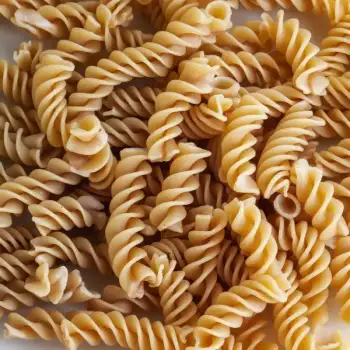Farfalle and Rotini are two types of pasta with distinct shapes suitable for different recipes: Farfalle's bow-tie shape is great for light salads and delicate sauces, while Rotini's spirals excel at trapping hearty sauces in baked dishes and soups.

Farfalle, often referred to as 'bow-tie pasta,' is an Italian pasta variety known for its unique 'butterfly' shape. The pinched middle helps to hold onto sauces, making it ideal for a variety of dishes.

Rotini is a type of helix- or corkscrew-shaped pasta that is excellent at trapping sauces within its spirals, providing a robust flavor with each bite. It's commonly used in both cold and hot dishes.
The main differences between Farfalle and Rotini lie in their shape, texture, and sauce retention. Farfalle has a flat surface with a pinched center, while Rotini is spiral-shaped. Farfalle offers a varied texture from the edges to the center, and Rotini provides a consistent bite with excellent sauce-catching capabilities.

Your ultimate Recipe Box, Meal Planner, and Cooking Class all in one
Farfalle is perfect for pasta salad recipes where a light, delicate appearance is desired. Its shapes pair well with simple vinaigrettes and fresh vegetables. When using Farfalle in salads, be sure to cook it al dente to maintain its shape and texture. Rotini's spirals are ideal for heartier salads with thicker dressings. The grooves hold onto dressings like pesto or mayo-based sauces, making every forkful flavorful. For best results, chill the Rotini after cooking before mixing with other ingredients.
In baked dishes, Farfalle contributes an elegant look and a texture that holds up well in the oven. It's particularly well-suited for lighter casseroles where the pasta is the star. Remember not to overcook it before baking to prevent it from becoming mushy. Rotini's sturdy structure makes it a great choice for heavier baked pasta dishes that include thick, meaty sauces and melted cheese. It maintains its shape and texture even when mixed with robust ingredients and baked.
Farfalle can be used in brothy soups that benefit from a touch of elegance. The pasta's edges provide a pleasant mouthfeel, but be cautious as it can overcook quickly in hot broth. Rotini is suitable for heartier soups and stews. Its spirals catch small bits of meat and vegetables, ensuring a flavorful spoonful every time. It's less prone to overcooking, making it a reliable choice for soups that need to simmer.
Both Farfalle and Rotini are similar in nutritional value, offering carbohydrates, protein, and a small amount of fiber with minimal fat. The exact nutritional content can vary based on whether they are made with whole wheat or enriched flour.
| Nutrient | Rotini ( per 2 Ounces (Dry) ) | Farfalle ( per 2 Ounces (Dry) ) |
|---|---|---|
| Fat | 1g | 1g |
| Fiber | 2g | 2g |
| Sodium | 0mg | 0mg |
| Protein | 7g | 7g |
| Calories | 200 | 200 |
| Carbohydrates | 42g | 42g |
Yes, Farfalle and Rotini can be used interchangeably; however, the dish's texture and sauce retention will differ based on the chosen pasta shape.
Farfalle is typically better for light pasta salads with vinaigrette, while Rotini is preferred for salads with thicker dressings.
Rotini is best for holding onto sauces due to its spiral shape, which traps sauce in its grooves.
When using Farfalle in soups, add it towards the end of cooking to prevent it from becoming too soft and losing its shape.
The nutritional difference between Farfalle and Rotini is minimal, with both providing similar amounts of calories, protein, and carbohydrates.